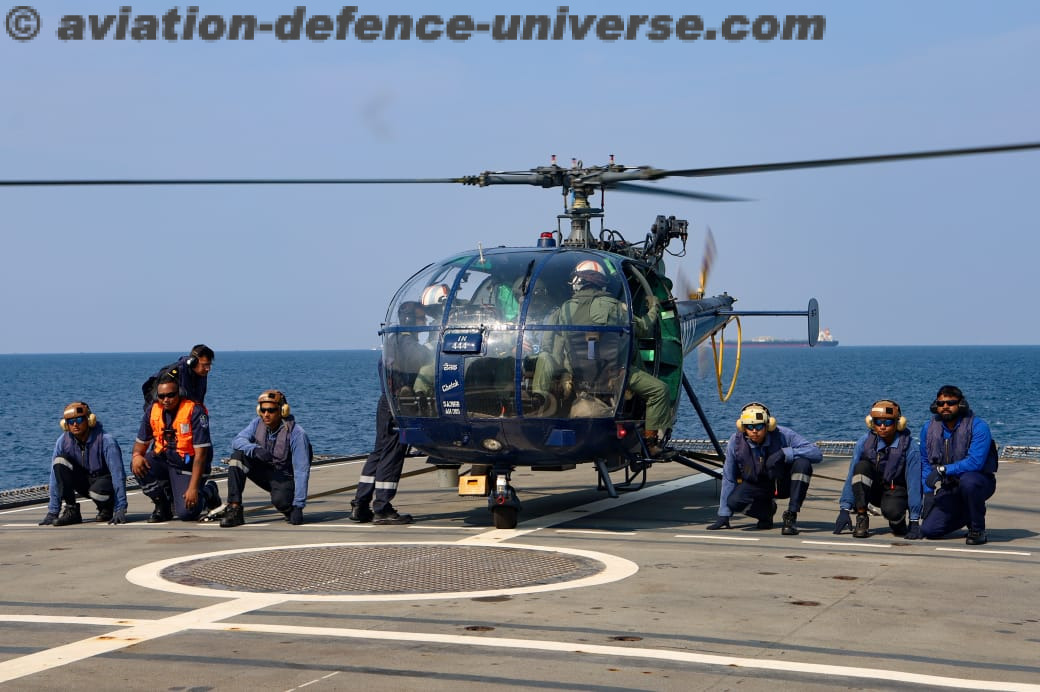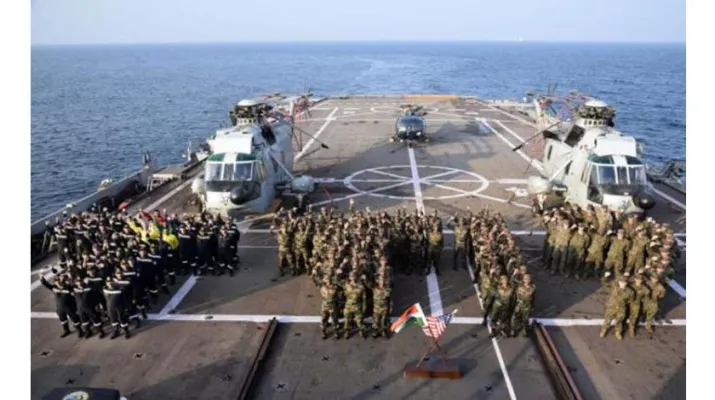By Divyam Nandrajog

New York. 11 February 2020. With increasing discussion of the rate of Chinese shipbuilding and the recent launches of major naval platforms, a dis -aggregation of platform capabilities will help steer the conversation towards the naval capabilities India already possesses and those which it must acquire. This paper undertakes a comparative analysis of the prevalent class of destroyers in the naval services of the United States, China and India. It aims to cover the larger element of the fighting force that can be fielded and consequently selects the Arleigh Burke class destroyers (Flight IIA) for the United States (since only 3 of the Zumwalt-class destroyers will be constructed), the Kolkata-class destroyers from India (since none of the Vishakapatnam-class destroyers have been commissioned yet) and the Type 052D Luyang III-class destroyers from China (since they will likely exceed the expectedly lower numbers of the Type 055 destroyers).
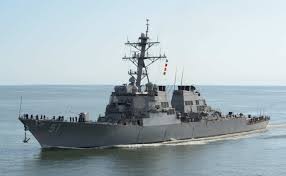
Any fielded military platform can be assessed in terms of the kinetic effects they deliver, their speed and freedom of movement, their ability to avoid or absorb punishment and their sensory capability to perceive their environment and targets. This set of metrics gives ready insight into the design tradeoffs made by the platform and its associated utility on the battlefield for a variety of mission sets. Beyond these, another set of metrics for cost, production run, date of introduction offer other insight into the likelihood and prevalence of their deployment.
Kinetic Effects Guns
The main gun armament of the Type 052D is the single barrel H/PJ-38 130mm gun with a range of 30 km and a rate of fire of 40 rounds a minute. The Arleigh Burke has a 127 mm (5”) gun with a range of 24 km (13 nautical miles) firing 16-20 rounds a minute. The Kolkata class, on the other hand, trades in a heavier gun and range for a much higher rate of fire. It carries a 76 mm Oto Melara Super Rapid Gun Mount capable of firing 120 rounds a minute to a range of 16 km with standard ammunition and 40 km with guided long-range ammunition.
Missiles
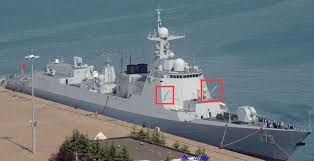
The Type 052D class is equipped to fire CJ-10 land attack cruise missiles (reported range 1500+ km with a warhead of 500 kg), HHQ-9 long range surface to air missiles (range 200 km), HQ-16 and DKA-10A medium range surface to air missiles (40 km), YJ-18 and YJ 83 anti-ship missiles (540 km with 300/180 kg; and 120 km with 165 kg), and the CY-5 family of anti-submarine missiles. It also carries two 7424B triple torpedo tubes (533mm) and four 18-tube launchers for decoy rockets. The 540-km range supersonic YJ-18 already gives the Luyang III an unmatched capability against a peer platform, with its high terminal speed providing both high kinetic energy at impact and less reaction time for an adversary. The eventual deployment of the subsonic1,000 km range YJ-100 anti-ship cruise missile (warhead 500 kg) will radically increase its standoff capability even against carrier battle groups.
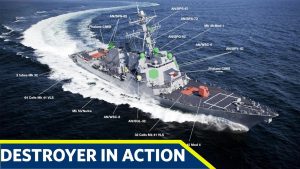
The Arleigh Burke class gave up its Harpoon missile capability in exchange for 2 helicopters when it was upgraded to the Flight IIA version. It carries no shorter-range dedicated anti-ship missile,comparable to the YJ-18, and even the preceding versions will eventually receive only the 310-km range Harpoon Block III. The Arleigh Burke does carry the tested subsonic Tomahawk cruise missile for land attack with a range of 1600 km. The US Navy hopes to modify the Tomahawk to anti-ship capability with a range of 1850 km (1000 nautical miles) in the next 8 years. The SM-2MR (range 166 km/90 nautical miles) provides some antiship capability and, coupled with the SM-6 (range 370 km) and Evolved Sea Sparrow Missile/ESSM (range 50 km) forms the air defense protection of the Arleigh Burke class. The Kolkata class, on the other hand, has a lower vertical launch capability. For its principle strike weapon, it carries a 16-cell universal vertical launcher module of the Brahmos supersonic missile with a range of 290 km. For air defense, it has up to 32 Barak-8/NG SAM systems with an engagement envelop of 100 km, though some sources note it at 70 km. One source reports the Kolkata class as carrying 2 x 32 Barak-8 missiles for a total of 64 on the ship (in addition to the Brahmos). It also carries twin torpedo launchers and the RBU-600 Smerch-2 rocket system (range
6 km) for ASW warfare.
The Type 052D has 64 vertical launch cells compared to the Arleigh Burke class’ 96 (of which 60 are dedicated to air defense). At least one source cites the Type 052D as having 88 vertical launch cells with 24 for dedicated use of the HHQ-10 SAM system for air defense. The modular nature of these cells however mean that the American destroyer can carry a greater quantity of missiles and deliver greater terminal effects on target, in a round for round exchange. The Kolkata class ship on the other hand only carries 16 Brahmos missiles that are its principal heavy ranged weapon, with another 32 cells for the Barak air defense system.
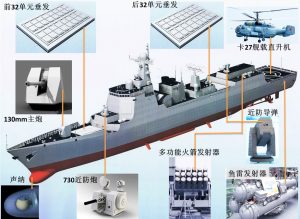
In terms of offensive capability, the Type 052D has better anti-shipping capability via the 540km YJ-18 (though the radar systems necessary to provide a weapons track may prove an issue) than either the Arleigh Burke or Kolkata class. Both the Chinese and American ships also out-range the
land attack capability of the Kolkata class with the CJ-10 (1500+ km) and Tomahawk (1600 km) significantly exceeding the 290 km Brahmos. The 200 km range HHQ-9 and 166 km SM-2MR also exceed even the higher reported 100 km range of the Barak 8.
Mobility
The Type 052D destroyer has a cruising range of 4,000 nautical miles at 15 knots (though at least source notes this at 4,500 nautical miles) and a maximum speed of 31 knots. compared to the Arleigh Burke’s 4,400 nautical miles at 20 knots. The Kolkata class (top speed in excess of 30 knots) has a decisive advantage in range, capable of cruising 8,000 nautical miles.
Powerplant
The Type 052D class destroyers are fitted with two QC-280 gas turbines generating 28MW each for a total of 56 MW and two MTU 20V 956TB92 diesel turbines generating 6MW each. The Arleigh Burke class in comparison has four GE LM-2500-30 gas turbine engines delivering 90,000 HP (67 MW) at a sustained rate and 105,000 HP (78 MW) for bursts, in addition to 3 Rolls Royce Allison 9140 gas turbine engines generating 7.5 MW. The Kolkata class has a twin Zorya M36E gas turbine plant with four Zorya-Mashproekt DT-59 gas turbines, each apparently rated for 16,550 kW for a total output of a little more than 66 MW. The addition of newer (and potentially power hungry systems like rail guns or stronger radars) will confer advantages on ships capable of generating higher power and the Luyang III would face the maximum disadvantage in absorbing a category of future technologies for this reason.
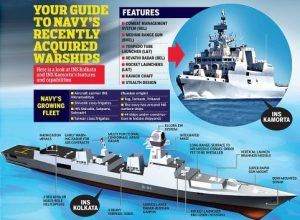
Sensory Acuity
The Luyang III has 4 flat paneled Type 346A/Type 518 L-band active electronically scanned array, an MGK-335MS-E hull mounted sonar, a towed array sonar and a variable depth sonar in addition to other optical-electronic sensors and jamming suite. The Arleigh Burke class on the other hand has the AN/SPY-1D radar system, operating in the S-band (later versions will have the SPY-6) and the SQS-53C(V)1 Hull-Mounted Sonar, with an estimated radar detection range of 310 km. The Kolkata-class uses the Israeli MF STAR S-band active electronically scanned array with a detection range greater than 250 km (some sources claim 450 km) and described as being lighter to comparable systems Compared to both the Chinese and American versions, the array being mounted higher on the mast provides a higher horizon detection range for low-flying objects, but limits the total size (and hence power) of the array. It has been described as being the equivalent of the Aegis and “on par” with the system the Type 052D carries. The Kolkata-class has a Humsa-NG hull mounted sonar but the lack of a towed sonar array and variable depth sonar affect its ASW capabilities since a hull mounted sonar is affected by sea conditions and temperatures and is less able to penetrate shadow zones where hostile submarines can hide. The destroyers were once slated to incorporate the Nagin towed array sonar system being developed indigenously but there is no readily available documentation for either its development or its operational status, with reports stating the program was terminated a few years ago.
Survivability
Size and signature
All 3 have been constructed with inward sloping hulls optimized for reduced radar cross section and are of comparable size, if not displacement. The Type 052D is 154 metres (505 feet) long, 18 metres wide and have a draft of 6.5 metres (the newer versions are around 161 metres long).Displacing 7500 tons, they are markedly lighter than the Arleigh Burke class that displaces 9200 tons with a length of 155 metres (509 feet), a beam of 18 metres and a draft of 6.35 metres. The Kolkata-class destroyers, on the other hand, are longer and slimmer than both the Chinese and American ships. They are 163 metres long, with a width of 17.4 metres and a draft of 6.5 metres and displace 7500 tons.
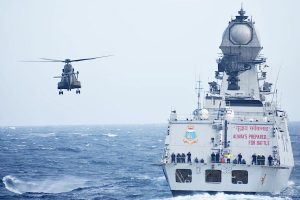
Aerial Assets
The Type 052D has a hangar facility that can accommodate a Harbin Z-9 or Kamov Ka-28 helicopter. The Arleigh Burke class on the other hand carries 2 SH-60 Sea Hawk (LAMPS MK III) helicopters which confers a greater ability to assist in ISR and ASW operations, not to mention adding a critical redundancy factor the Chinese destroyer lacks. The Kolkata class destroyers are also equipped to carry two helicopters, likely to be HAL Cheetahs, Sea Kings or Dhruvs though a shortage of naval helicopters in general mean they likely sail without one or share air assets with other naval ships. The Arleigh Burke class is also aided by the placing of shock absorbers on reduction gears that isolate sound and reduce the ship’s acoustic signature. The Arleigh Burke class also has a remote mine hunting capability that can search in autonomous and manual modes, and is linked to the undersea combat systems on the ship.
CIWS and Point defense
The Type 052D carries the H/PJ-12 30mm CIWS with a maximum rate of fire of 10,000 rounds a minute and two 30-mm machine guns. The Arleigh Burke class carries a complement of the Evolved Sea Sparrow Missiles in VLS configuration and two 25-mm chain guns. The Kolkata class utilizes 4 of the proven Russian AK-630 comprising a 6-barreled 30 mm system capable of
firing 5,000 rounds a minute.
Production run
There are approximately 20 Type 052D destroyers in active service (11) or in various stages of launch and fitting out with 26 ships projected in the class. There are 66 Arleigh Burke-class destroyers in active service, with 46 Flight IIA planned, while the Kolkata-class will complete its production run with 3 destroyers.
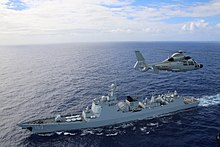
Cost
The Type 052D costs roughly $432 million (estimating from the “half of 6 billion yuan cost of the Type 055 destroyer”). The last asking price for an Arleigh Burke class destroyer was $1.82 billion dollars, more than 4 times the cost of a Type 052D class ship. The Type 052D’s crew complement of 280 is lower than the Arleigh Burke class’ 329 – 380 and will likely reduce some of the operating cost. The Kolkata-class destroyers, on the other hand, came for about $950 million apiece and have a crew complement variously described as between 325 and 440.
Conclusion
Qualitatively, the Luyang III brings a very competitive set of capabilities to an engagement with an offensive reach matching American land-attack capabilities, and exceeding both peer American and Indian ships in anti-ship capabilities. The American ship however carries a greater number of
vertical launch cells that pack a greater punch at shorter ranges. The Luyang III class has a vulnerability in ASW capability by carrying only one helicopter though Kolkata class definitely loses out through the lack of a towed sonar array and the current lack of naval multi-role helicopters
in the Indian Navy (despite being able to carry 2). The Kolkata class and Arleigh Burke class destroyers both generate more propulsion than the Luyang III that will be helpful in absorbing future technologies. On the other hand, the Type 052D destroyers score a major victory in cost – they cost a quarter of an Arleigh Burke class destroyer and less than half of the Kolkata class ships.
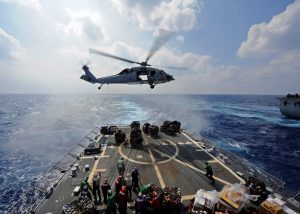
In addition, they heavily outnumber the Indian destroyers 6:1 (eventually almost 9:1) though they still number less than a third of the current Arleigh Burke destroyers in service.
With the above analysis, it is important to remember that single shipcombat rarely occurs in modern warfare and the Indian effort must be oriented towards finding the critical force structure and employment mixture that can produce optimal combat outcomes. The tests of the Cooperative Engagement Capability allowing networked warfare by distributed sensor-shooter mechanisms is a step in the right direction that will help offset platform shortcomings and provide battlefield advantages.
Divyam Nandrajog is Coordinator, Empirical Analysis of Naval Warfare Project under Dr. Stephen D. Biddle at the Arnold A. Saltzman Institute of War and Peace Studies at Columbia University. The views expressed here are personal and not those of affiliated institutions. The views in the article are solely the author’s. He can be contacted at editor.adu@gmail.com
































